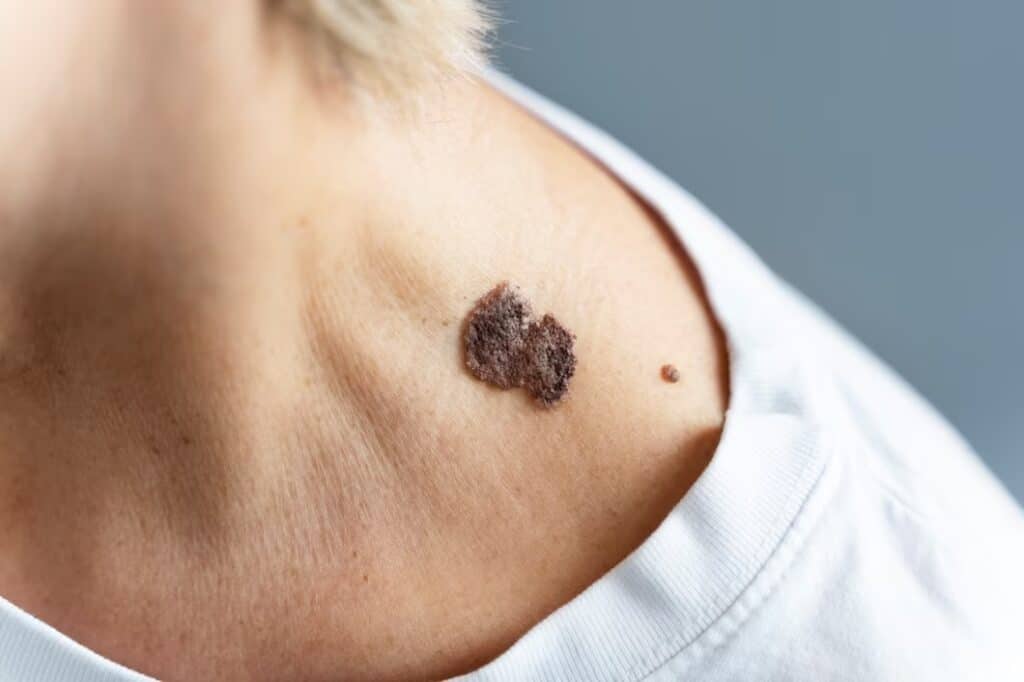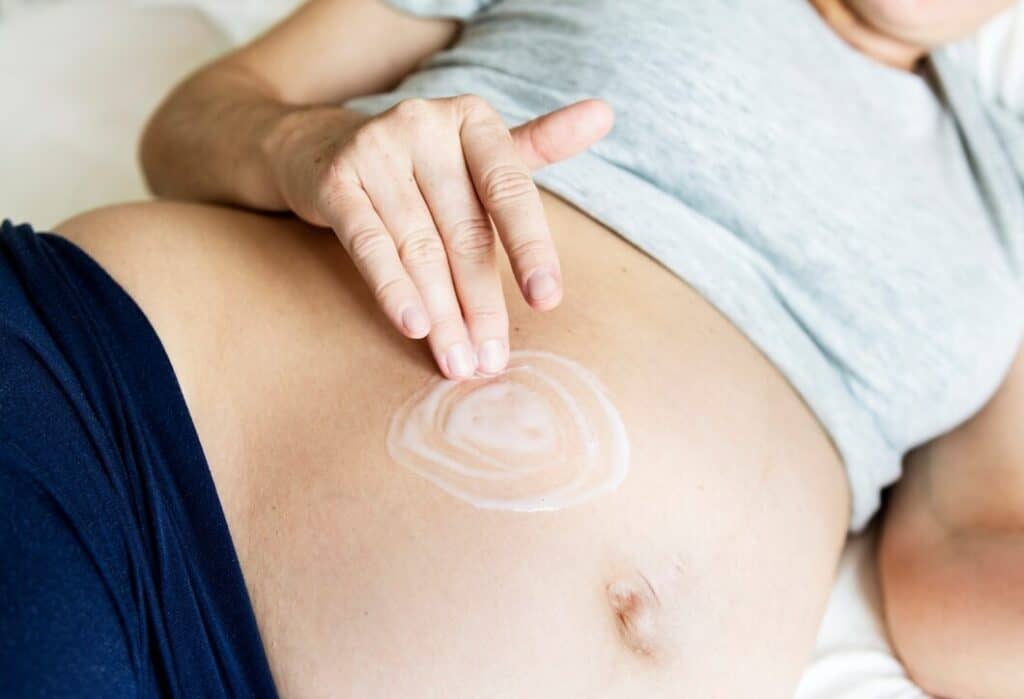Skin tags are a common skin condition that can occur in both men and women. They are small, benign growths that typically appear on areas of the body where skin rubs against skin or clothing. While skin tags are generally harmless, they can be unsightly and cause discomfort, especially if they appear on sensitive areas of the body, such as the nipple during pregnancy.
During pregnancy, many women experience a range of changes to their body, including the development of skin tags. Skin tags on the nipple can be particularly concerning, as they can be mistaken for other, more serious conditions. However, in most cases, skin tags on the nipple during pregnancy are harmless and do not require medical treatment. Understanding the causes and symptoms of skin tags during pregnancy can help women identify and manage this common condition.
Key Takeaways
- Skin tags are a common skin condition that can occur in both men and women.
- Skin tags on the nipple during pregnancy are generally harmless and do not require medical treatment.
- Understanding the causes and symptoms of skin tags during pregnancy can help women identify and manage this common condition.
Understanding Skin Tags
Skin tags are benign skin growths that are usually painless and harmless. They are made up of collagen fibers and blood vessels and can occur on any part of the body, including the nipple during pregnancy. Skin tags are differentiated from warts, which are caused by a virus, and are noncancerous.
Skin tags can vary in color and size, and can be as small as a grain of rice or as large as a grape. They are more common in areas where skin rubs against skin, such as the neck, underarms, and groin. However, they can also occur on the nipple during pregnancy due to hormonal changes.
Skin tags are usually not a cause for concern and do not require treatment. However, if they become irritated or bleed, a doctor may recommend removal. Removal options include freezing, cutting, or burning the skin tag off.
Overall, skin tags on the nipple during pregnancy are a common and harmless occurrence. If you have concerns about skin tags or any other skin growths, it is always best to consult with a medical professional.
Skin Tags and Pregnancy
Skin tags are a common occurrence during pregnancy, particularly in the second trimester. These small, benign growths are often caused by hormonal changes, specifically an increase in estrogen levels and other sex hormones. While they can appear anywhere on the body, skin tags are especially common on the nipples during pregnancy.
The exact cause of pregnancy skin tags is not fully understood, but it is believed to be related to the hormonal changes that occur during pregnancy. As estrogen levels rise, the body produces more collagen, which can lead to the growth of skin tags. Additionally, the developing fetus can put pressure on the skin, which may also contribute to the development of skin tags.

Fortunately, skin tags on the nipples during pregnancy are typically harmless and do not pose any health risks to the mother or developing fetus. In most cases, they will go away on their own after the baby is born. However, if they are causing discomfort or interfering with breastfeeding, they can be removed by a healthcare provider.
It is important to note that while skin tags are generally harmless, they can sometimes be a sign of an underlying medical condition. If you notice any changes in the appearance or texture of your skin tags, or if they are accompanied by other symptoms such as pain or bleeding, it is important to consult with your healthcare provider to rule out any potential health concerns.
In summary, skin tags on the nipples during pregnancy are a common occurrence caused by hormonal changes and pressure from the developing fetus. While they are generally harmless, it is important to monitor them for any changes and consult with a healthcare provider if you have any concerns.
Causes of Skin Tags During Pregnancy
Skin tags are common during pregnancy, and they are small, harmless growths that can appear on various parts of the body, including the nipples. While the exact cause of skin tags on the nipple during pregnancy is not known, several factors are believed to contribute to their development.
Hormonal Fluctuations
Hormonal changes are a common cause of skin tags during pregnancy. The increase in hormones during pregnancy can cause the skin to become more sensitive, leading to the development of skin tags.
Friction
Friction is another factor that can cause skin tags on the nipple during pregnancy. Tight clothing, skin folds, and other sources of friction can cause irritation to the skin, leading to the development of skin tags.
Weight Gain and Obesity
Weight gain and obesity are also believed to be factors that contribute to the development of skin tags during pregnancy. The excess weight can cause the skin to stretch, leading to the formation of skin tags.
Genetics and Family History
Genetics and family history may also play a role in the development of skin tags during pregnancy. If a woman has a family history of skin tags, she may be more likely to develop them during pregnancy.
Stretch Marks
Stretch marks are another common occurrence during pregnancy, and they can also contribute to the development of skin tags. Stretch marks can cause the skin to become more sensitive, leading to the formation of skin tags.
Sebaceous Glands
Sebaceous glands are small glands in the skin that produce oil. These glands can become blocked, leading to the development of skin tags on the nipple during pregnancy.
In conclusion, skin tags on the nipple during pregnancy can be caused by a variety of factors, including hormonal fluctuations, friction, weight gain and obesity, genetics and family history, stretch marks, and blocked sebaceous glands. While skin tags are harmless, it is essential to consult a healthcare provider if they become painful or start to bleed.
Locations of Skin Tags
Skin tags can appear in various locations on the body, including the neck, breasts, nipples, underarms, arms, vagina, and areas where skin rubs together. However, the occurrence of skin tags on the nipple during pregnancy is common and can be a cause for concern for some women.
Skin tags on the nipple or areola can be small or large, and they may be flesh-colored or darker. They typically do not cause any pain or discomfort, but they can be unsightly and make some women feel self-conscious.
Skin tags on the breasts or nipples during pregnancy are thought to be caused by hormonal changes in the body. As the body prepares for breastfeeding, the skin on the breasts and nipples can become more sensitive and prone to developing skin tags.

It is important to note that skin tags are generally harmless and do not require medical treatment. However, if a skin tag becomes irritated or inflamed, it may need to be removed by a healthcare provider.
In conclusion, skin tags can appear in various locations on the body, including the nipple and breast area during pregnancy. While they may be unsightly, they are generally harmless and do not require medical treatment unless they become irritated or inflamed.
Symptoms and When to Seek Medical Attention
Skin tags on the nipple during pregnancy are common and usually harmless. However, some women may experience symptoms that require medical attention. It is important to know when to seek medical help to ensure the health of both the mother and the baby.
Symptoms of skin tags on the nipple during pregnancy may include tenderness, discomfort, or itching. Some women may also experience pain or bleeding. If any of these symptoms occur, it is recommended to seek medical attention.
In some cases, skin tags on the nipple during pregnancy may be a sign of a more serious condition. A clinical study published in the Journal of Obstetrics and Gynaecology Canada found that skin tags on the nipple may be associated with an increased risk of breast cancer. Therefore, it is important to have any new or unusual growths on the nipple checked by a healthcare provider.
If a woman notices any changes in her nipple or breast during pregnancy, she should seek medical attention immediately. Early detection and treatment of breast cancer can greatly improve the chances of a successful outcome.
In summary, skin tags on the nipple during pregnancy are usually harmless, but it is important to be aware of any symptoms that may require medical attention. If a woman experiences tenderness, discomfort, itching, pain, or bleeding, she should seek medical help. Additionally, any new or unusual growths on the nipple should be checked by a healthcare provider to ensure the health of both the mother and the baby.
Diagnosis and Tests
If a woman notices a skin tag on her nipple during pregnancy, she should consult with her obstetrician or dermatologist. The doctor will examine the skin tag and ask questions about the patient’s medical history.
In some cases, the doctor may perform a biopsy to rule out any other potential causes of the skin tag. A biopsy involves taking a small sample of the skin tag and examining it under a microscope.
In addition to a physical examination and biopsy, the doctor may also recommend further testing such as a mammogram or ultrasound to ensure that the skin tag is not a sign of breast cancer.
It is important to note that skin tags on the nipple during pregnancy are usually benign and do not pose a health risk to the mother or baby. However, it is always best to consult with a healthcare professional to ensure proper diagnosis and treatment.
Resources such as the American Academy of Dermatology and the American College of Obstetricians and Gynecologists can provide additional information and resources for women who are concerned about skin tags on their nipples during pregnancy.
Treatment Options for Skin Tags
There are several treatment options available for skin tags on the nipple during pregnancy. The choice of treatment depends on the size, location, and number of skin tags, as well as the preferences of the patient.
Removal and Excision
Removal and excision are common treatment options for skin tags. This involves cutting off the skin tag with a scalpel or scissors. The procedure can be done in a doctor’s office and usually takes only a few minutes. Local anesthesia may be used to numb the area before the procedure.
Cryotherapy and Liquid Nitrogen
Cryotherapy and liquid nitrogen are also effective treatments for skin tags. This involves freezing the skin tag with liquid nitrogen, which causes it to fall off after a few days. The procedure is quick and can be done in a doctor’s office. However, it may cause some pain and discomfort.
Medical Treatments
Medical treatments such as salicylic acid, lactic acid, and acitretin can also be used to treat skin tags. These treatments work by dissolving the skin tag over time. They are usually applied topically and may take several weeks to be effective.
Carbon Dioxide Laser
A carbon dioxide laser can also be used to remove skin tags. This involves using a laser to burn off the skin tag. The procedure is quick and can be done in a doctor’s office. However, it may cause some pain and discomfort.
Overall, there are several effective treatment options available for skin tags on the nipple during pregnancy. Patients should discuss their options with their doctor to determine the best course of action.
Home Remedies for Skin Tags
Skin tags on the nipple during pregnancy can be an uncomfortable and unsightly issue for many women. While medical treatment is always an option, there are also several home remedies that may help to shrink and even make the skin tags fall off naturally.
One popular home remedy is tea tree oil, which has natural antiseptic and anti-inflammatory properties. To use tea tree oil, dilute it with a carrier oil such as coconut oil and apply it to the skin tag with a cotton swab. Repeat this process several times a day until the skin tag shrinks and falls off.

Garlic is another home remedy that may help to shrink skin tags. Crush a clove of garlic and apply it directly to the skin tag, covering it with a bandage. Leave the garlic on for several hours or overnight, then rinse with warm water. Repeat this process daily until the skin tag falls off.
Other home remedies for skin tags include apple cider vinegar, which can be applied to the skin tag with a cotton ball several times a day, and castor oil, which can be applied directly to the skin tag and left on overnight.
It is important to note that while home remedies may be effective for some people, they may not work for everyone. It is also important to consult with a healthcare provider before trying any home remedies, especially if you are pregnant or have any underlying health conditions.
Skin Tags and Breastfeeding
Skin tags are small, harmless growths that can appear on the skin of the nipple during pregnancy. While they are not dangerous, they can be uncomfortable and unsightly. Many women who have skin tags on their nipples wonder if it is safe to breastfeed their babies.
Breastfeeding with skin tags is generally safe. However, it is important to keep the area clean and dry to prevent infection. Skin tags can become irritated and inflamed, which can increase the risk of infection. It is also important to avoid rubbing or pulling on the skin tags, as this can cause them to bleed or become more irritated.
If you notice any signs of infection, such as redness, swelling, or discharge, contact your healthcare provider right away. They may recommend an over-the-counter cream or ointment to help reduce inflammation and prevent infection.

In some cases, skin tags may interfere with breastfeeding. If the skin tags are large or located in an area that makes it difficult to latch the baby onto the breast, you may need to have them removed. Your healthcare provider can help you determine the best course of action.
Overall, skin tags on the nipple are a common occurrence during pregnancy and breastfeeding. While they can be uncomfortable, they are generally harmless. By keeping the area clean and dry and avoiding irritation, you can safely breastfeed your baby without any issues.
Prevention of Skin Tags
While skin tags on the nipple during pregnancy are common, there are steps that can be taken to prevent their occurrence. The following tips can help reduce the likelihood of developing skin tags:
- Keep the area clean and dry: Moisture can increase the risk of skin tags, so keeping the nipple area clean and dry is important.
- Wear a supportive bra: A well-fitting, supportive bra can help reduce friction and irritation on the nipple area, which can help prevent skin tags from forming.
- Avoid tight clothing: Tight clothing can also increase friction and irritation on the nipple area, so it’s best to choose loose-fitting clothing that doesn’t rub against the skin.
- Use anti-inflammatory creams: Anti-inflammatory creams can help reduce inflammation and irritation on the nipple area, which can help prevent skin tags from forming.
By following these simple steps, pregnant women can help reduce their risk of developing skin tags on the nipple area. If skin tags do occur, it’s important to remember that they are usually harmless and can be easily removed by a dermatologist if desired.
Skin Conditions Similar to Skin Tags
Skin tags on the nipple during pregnancy are a common occurrence. However, there are several other skin conditions that can appear similar to skin tags. It is important to be aware of these conditions to ensure proper diagnosis and treatment.
One such condition is atopic dermatitis, also known as eczema. This is a chronic condition that causes itchy, red, and inflamed skin. Acanthosis nigricans is another condition that can appear similar to skin tags. It is characterized by dark, thickened skin in areas such as the neck, armpits, and groin.
Epidermal nevus is a rare condition that causes raised, wart-like growths on the skin. Nevoid hyperkeratosis and hyperkeratosis of the nipple and areola are two conditions that cause thickened, scaly skin in the nipple and areola area. Pregnancy-associated hyperkeratosis is a condition that can occur during pregnancy and causes thickened, scaly skin in various areas of the body.
Nipple hyperkeratosis and orthokeratotic hyperkeratosis are two conditions that cause thickened, scaly skin specifically in the nipple area. Papillomatosis is a condition that causes small, wart-like growths on the skin. Acanthosis is a condition that causes thickened, velvety skin in various areas of the body.
Montgomery glands are small bumps on the areola that secrete oil to lubricate the nipple. Nevoid hyperkeratosis of the nipple and areola and pregnancy-associated hyperkeratosis of the nipple are two conditions that can cause thickened, scaly skin specifically in the nipple and areola area.
Skin conditions can occur unilaterally (affecting only one side of the body) or bilaterally (affecting both sides of the body). Ichthyosis is a condition that causes dry, scaly skin all over the body. Fibroadenoma is a benign breast tumor that can cause lumps in the breast tissue. Inflammation can also cause skin changes that may appear similar to skin tags.
It is important to consult a healthcare provider if any skin changes occur. They can provide an accurate diagnosis and recommend appropriate treatment options.
Conclusion
In conclusion, skin tags on the nipple during pregnancy are a common occurrence that can be easily managed. While they may cause some discomfort or concern for the mother, they are generally harmless and can be removed if desired.
It is important for pregnant women to maintain good hygiene and monitor any changes in their skin, including the appearance of skin tags. If a skin tag on the nipple becomes painful or inflamed, it is recommended to seek medical attention to rule out any underlying issues.
Overall, with proper care and attention, skin tags on the nipple during pregnancy should not cause significant concern. However, if a mother has any doubts or questions about their skin tags, it is always best to consult with a healthcare professional for guidance and support.
Related posts:
Frequently Asked Questions
Yes, skin tags on nipples can be a normal occurrence during pregnancy. In fact, they are quite common and can be caused by hormonal changes in the body.
Skin tags on nipples can be caused by hormonal changes in the body during pregnancy. These hormonal changes can cause the skin to become more sensitive and prone to developing skin tags.
Skin tags on nipples are generally not harmful during pregnancy. However, they can be uncomfortable or unsightly for some women.
It is generally not recommended to remove skin tags on nipples while pregnant, as this can cause unnecessary stress on the body. However, if a skin tag is causing discomfort or pain, a doctor may be able to remove it safely.
Skin tags on nipples may disappear after pregnancy, but they can also remain. It is important to note that skin tags are harmless and do not pose any health risks.
There are several safe and effective ways to treat skin tags on nipples during pregnancy, including using tea tree oil, apple cider vinegar, or over-the-counter skin tag removal products. However, it is important to consult with a doctor before trying any at-home remedies to ensure they are safe for use during pregnancy.
